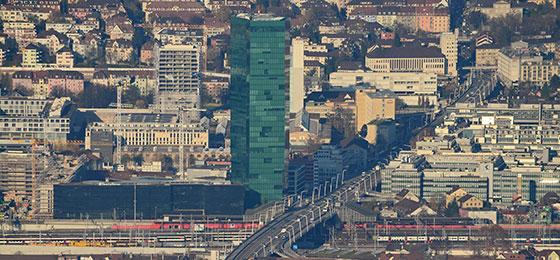Achieving better traffic management

It is a well-known issue that many roads have traffic jams during peak periods. Big data is still almost never used for traffic management.
The data used by the researchers includes tracking data – i.e. GPS data from smartphones. As this is so ubiquitous and easy to collect, it has the potential to become an invaluable resource for traffic modelling in Switzerland.
The data is fed into MATSim (which stands for Multi-Agent Transport Simulation), an open-source platform for developing agent-based simulations; researchers began developing the platform around 2006 and it has been continuously improved ever since. ‘Agent-based’ means that individual people, described as agents, are simulated and then put together to form a population. This means that differences between individual people, i.e. the typical heterogeneity found within a population, is taken into account. The NRP 75 project has enabled even more refined analyses of how people move about and where traffic jams develop, for example.
People were recruited directly for a mobility study as part of the NRP 75 project. They had to install a special app and fill out questionnaires. This approach offered a significant benefit in that alongside the tracking data, additional details about the participants were also collected – not just age and gender, but also income, car ownership, and other information. This enabled more specific analyses, such as that into the changes in mobility behaviour during the coronavirus pandemic.
Application: mobility during the coronavirus pandemic
In March 2020, participants from a previous survey were asked whether they would be willing to provide their tracking data once again for the study of behaviour during the pandemic. More than a million person-trips have thus been recorded since then, from over 1600 participants, and combined with information from three small surveys asking about participants’ work situation and state of health.
The central findings are the following: 1. Working from home is becoming increasingly accepted. 2. After the lockdown in the spring of 2020, people have been out and about less than before the lockdown.
Analysis of the data recorded nicely shows that although transport use recovered and then stabilised after the lockdown, only around 80 percent of people leave the house every day. This is significantly below the pre-lockdown level of around 90 percent. The reason for this decline is primarily working from home, but also short-time work and the newly unemployed.
Another interesting finding from the investigation is the fact that there are no significant differences between social classes in Switzerland.
Cycle boom now also for commuting
The surprise was and is the increased use of bicycles. Although this rise initially appeared to have been the result of a fitness and leisure boom, a current analysis of the purpose of journeys has shown that bicycles are increasingly being used for all purposes, including travelling to work. However, weather has a significant impact on bicycle use.
It is already well known that public transport was avoided almost entirely during the initial weeks of the 2020 lockdown. It was also presumed that buses, trams, and trains would continue to be less preferred means of transport. This has now been confirmed: use of these is down by 40 to 60 percent compared with the number of kilometres travelled in 2019.
The research is still ongoing, for example to gain a better understanding of unexpected events. This might be an accident on a railway line causing days of closure, or a pandemic. MATSim is being used to simulate the spread of the pandemic in a project under NRP 78 ‘Covid-19’.
International and interdisciplinary collaboration
The ‘Using data traces to improve transport systems’ project under NRP 75 was an international and interdisciplinary research collaboration between the research groups of the Institute for Transport Planning and Systems and the Learning & Adaptive Systems Group at ETH Zurich, together with research groups from TU Berlin and TU Graz.
